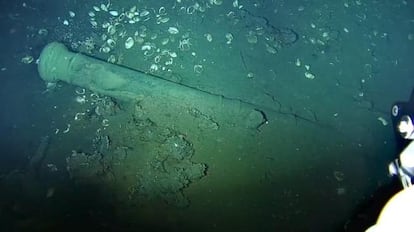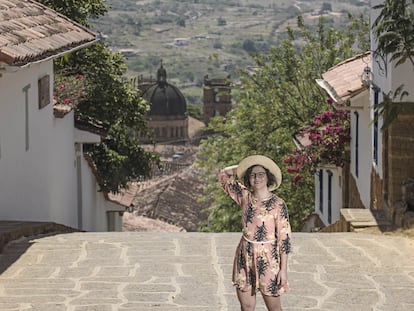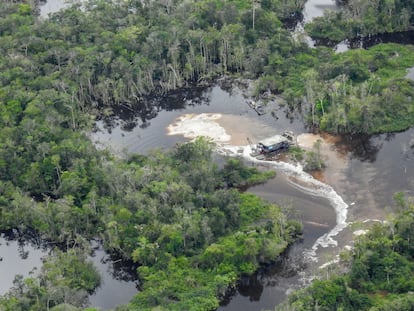Gold ingots, Chinese tableware, swords and cannons: The new findings from the Spanish galleon ‘San José’
The Colombian government has announced that it also found two other shipwrecks in the same area


New images of the Spanish galleon San José revealed this Monday by the Colombian government, show almost intact Chinese crockery, several gold ingots, hundreds of eight-real coins, several cannons made in Seville, in the south of Spain, in 1665, swords, suitcases and many other small treasures unseen until now. The exploration of the depths of the Caribbean Sea near Cartagena, where the remains of the ship are buried, also revealed fish, crabs, mollusks and corals growing alongside the coveted booty.
In a press conference from Casa de Nariño, Colombian President Iván Duque stated that the findings were discovered thanks to state-of-the-art recording equipment. A remotely operated vehicle descended more than 1,000 meters to explore the galleon’s nooks and crannies, taking high-quality images in order to document and protect the items within.
Duque also explained that two new vessels were discovered near the San José galleon. “One of them belongs to the colonial period and the other corresponds to the republican period,” said the president. He added that further explorations may reveal at least 10 similar shipwrecks nearby.
“In recent years, we have acquired equipment to reach the depths of the sea and obtain high-quality images, allowing us to protect the integrity of the treasure and carry out permanent monitoring, so that everything is preserved and protected until the extraction can be carried out,” he explained.
The San José galleon set sail from Spain in 1706, along with other ships bound for the Caribbean Sea, and arrived in Cartagena after a month of sailing. Two years later, in 1708, it left Cartagena for Panama loaded with ingots, gold and silver coins, valued at 11 million pesos at the time. The fleet was attacked by English ships and sank near the island of Barú, a few kilometers from Cartagena, in the Colombian Caribbean Sea. The galleon’s remains were discovered on November 27, 2015 by researchers from the Colombian Institute of Anthropology and History (ICANH) and the Colombian National Navy.
Defense Minister Diego Molano, Admiral and Navy commander Gabriel Pérez Garcés and Maritime General Directorate director José Joaquín Amézquita also participated in Monday’s presentation. Molano explained that this expedition makes it possible to ensure “with total certainty” that the treasure of the San José galleon will be delivered intact to the next administration. “In these observation campaigns, high-tech equipment and computer tools were used to process data and monitor the status of the shipwreck,” said the minister.

Admiral Pérez announced that, in recent years, four expeditions had revealed that the area around the galleon had not been reached by human hands. “Now, with these new technologies, we have been able to verify that everything is in its place, and we have been able to get closer than anyone had ever gotten before.”
The commander of the Navy explained that, in addition to the equipment, the expedition was made possible by the knowledge of an interdisciplinary group of Colombian experts who specialize in safety and conservation of cultural artifacts.
Nelson Freddy Padilla, author of the book El galeón San José y otros tesoros [The San José galleon and other treasures], explains that the announcement is important because it reveals new images of the shipwreck area. However, Padilla points out, the government has not provided precise information about the site, leaving many questions unanswered: “When were the videos recorded? What equipment was used? What company is going to carry out the rescue of all those goods?” asks the researcher. And he concludes: “Years go by, and the issue of the dozens of sunken galleons in Colombian seas is not resolved in depth. There is no serious scientific plan to remove them and put all that knowledge at the service of culture.”
Tu suscripción se está usando en otro dispositivo
¿Quieres añadir otro usuario a tu suscripción?
Si continúas leyendo en este dispositivo, no se podrá leer en el otro.
FlechaTu suscripción se está usando en otro dispositivo y solo puedes acceder a EL PAÍS desde un dispositivo a la vez.
Si quieres compartir tu cuenta, cambia tu suscripción a la modalidad Premium, así podrás añadir otro usuario. Cada uno accederá con su propia cuenta de email, lo que os permitirá personalizar vuestra experiencia en EL PAÍS.
¿Tienes una suscripción de empresa? Accede aquí para contratar más cuentas.
En el caso de no saber quién está usando tu cuenta, te recomendamos cambiar tu contraseña aquí.
Si decides continuar compartiendo tu cuenta, este mensaje se mostrará en tu dispositivo y en el de la otra persona que está usando tu cuenta de forma indefinida, afectando a tu experiencia de lectura. Puedes consultar aquí los términos y condiciones de la suscripción digital.
More information
Últimas noticias
Most viewed
- Sinaloa Cartel war is taking its toll on Los Chapitos
- Oona Chaplin: ‘I told James Cameron that I was living in a treehouse and starting a permaculture project with a friend’
- Reinhard Genzel, Nobel laureate in physics: ‘One-minute videos will never give you the truth’
- Why the price of coffee has skyrocketed: from Brazilian plantations to specialty coffee houses
- Silver prices are going crazy: This is what’s fueling the rally










































